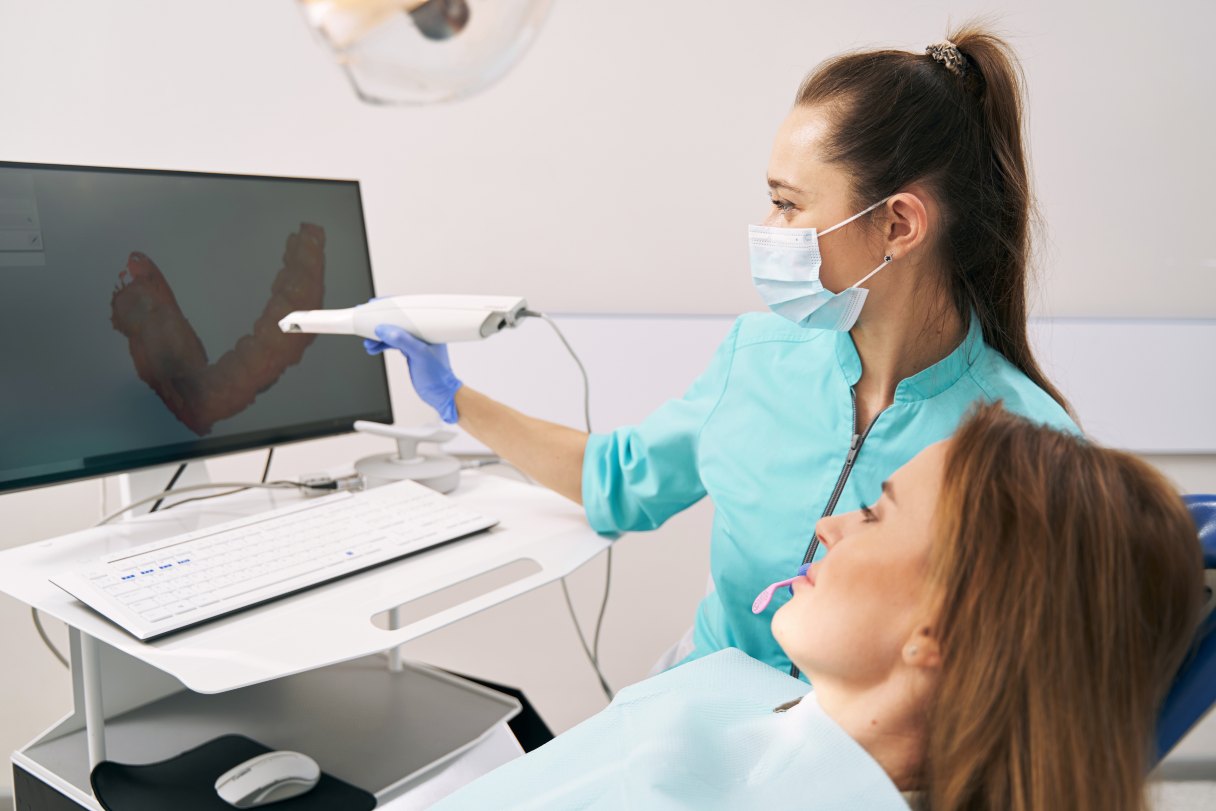Going to the dentist can be stressful. A fear of the unknown and whether it will be a painful experience can prevent people from visiting their dentist. Fortunately, dentistry has come a long way and, in recent years, many dental clinics are using advanced technologies — also known as digital dentistry — to help reduce the stress of a dental visit.
Read on to learn more about digital dentistry and how it can help transform your dental care experience.
What Is Digital Dentistry?
Digital dentistry is the term for the use of digital technology, including equipment and software, to perform dental procedures.1
Digital dentistry has been used since the 1970s when computed tomography (CT) scanners were first used in the practice of dentistry. Today, dentists have access to more advanced technologies, including artificial intelligence (AI), machine learning (ML), virtual reality (VR), augmented reality (AR), digital smile design (DSD), 3D printing, teledentistry and chairside economical restoration of esthetic ceramics (CEREC).1
These newer technologies can help provide dental care with minimal hassle and pain.
Benefits of Digital Dentistry
There are several advantages to seeing a dentist who incorporates digital dentistry into their practice. These can include:
- Improved accuracy. The use of modern technology can improve diagnosis and treatment in dentistry.1 However, your dentist should avoid relying solely on these tools and balance their use of digital dentistry with their own clinical experience.1 Having access to dentists who use this technology can help ensure that you get the right results from your dental procedure and lessen return visits for adjustments.
- Reduced chair time. Using computer-aided design/computer-aided manufacturing (CAD/CAM) and 3D printing can greatly reduce the time required for a dental visit.2 Same-day services for dental restorations may be completed in a single session.2 Eliminating the need for additional appointments helps minimize the impact of dental care on your valuable time.
- Enhanced patient experience. The use of advanced technology in dentistry has led to shorter and less frequent office visits, resulting in increased patient satisfaction. A recent study described the positive impact of digital dentistry on oral health-related quality of life.3
- Cost savings. The investment cost for the technology required for digital dentistry may initially increase your dental treatment costs. However, you will potentially save time and money by having shorter and less frequent appointments for your dental work. Also, the true cost-effectiveness of using digital technology needs further study.3 Ask your dentist about potential cost savings using digital technology.
- Increased access to dental care. The COVID-19 pandemic saw a rise in the use of telehealth across multiple specialties, including primary and urgent care.4 While teledentistry dates back to the early 1990s, its use in dentistry also saw an increase during the COVID-19 pandemic as dentists and patients worked to minimize person-to-person contact.5 Furthermore, the use of teledentistry has greatly improved access for those who live in rural and underserved communities.1 This increased access to care can enable more control over your time and may eliminate the need to travel to the dentist's office for follow-up visits.
How Is Digital Dentistry Used?
Digital dentistry has streamlined many procedures and manufacturing processes that take significantly longer to complete manually. These include multiple aspects of restorative dentistry, orthodontics and implantology.1
Restorative dentistry
Restorative dentistry offers long-lasting repair options for teeth that have suffered damage from decay or other causes.
- CEREC crowns. The CEREC CAD/CAM system allows you to undergo restorative treatments, including the placement of a tooth crown, in a single office visit.1
- Digital dentures. Intraoral scanning is used to obtain detailed impressions of your teeth and gums. AI and ML algorithms then use this information to design dental bridges and dentures. This technology can give you the best possible fit for your denture needs.1
- Inlays and onlays. CAD/CAM technology for digital impressions can be used to develop your inlays and onlays. A 2021 study revealed that the fitting of inlays and onlays using digital technology is as reliable as those created with traditional non-digital impressions.6 Digital impressions also eliminate the need for you to hold an uncomfortable physical mold in your mouth for an extended period.
- Veneers. Digital smile design has been instrumental in the planning and manufacturing of composite veneers. When comparing digital scans to traditional photography, researchers saw a significant difference in results, with the digital 2D and 3D methods prevailing.7 Digital scans are also faster than traditional photography and shorten your overall appointment time.
Orthodontics
As you lost your baby teeth and your permanent teeth began to appear, your dentist may have discovered that there was not quite enough room for all your teeth to fit comfortably in your mouth. Orthodontics provides solutions to properly align your teeth, giving you the best possible smile. Digital dentistry can help determine the best orthodontic solution.
- Invisalign® treatment. Invisalign from Align Technology, Inc. are commonly used clear aligners. They are created using proprietary SmartTrack™ material specifically designed for use with their system. Invisalign SmileView™ simulation is a software tool that enables you — during your initial office visit — to see what your smile will look like after treatment.8
- Clear aligners. Clear aligner therapy (CAT) gives you the option of virtually invisible braces that are comfortable and can be removed for eating and brushing your teeth. Traditionally, manual impressions are obtained to create the model used to manufacture the aligners. Today, many practitioners use more accurate digital impression scans for this purpose.9
- Digital impressions. Digital intraoral scanners capture detailed images of your teeth and surrounding structures. The images are transferred to a CAD/CAM system to design and produce your dental restorations, such as crowns and bridges.1
Dental implants
Dental implants are artificial tooth roots implanted into the jawbone that serve as a sturdy base for fixed or removable replacement teeth and are part of maintaining good oral health if you've lost or damaged teeth. Here are some ways digital dentistry can help with dental implants:
- Digital implant planning. 3D technology, including CT and cone-beam CT (CBCT), is used to evaluate your bone quality and volume as well as any anatomical abnormalities. This information is processed and evaluated using virtual implant simulation software, which simulates the implant process.10
- 3D printing of surgical guides. Once the simulated implant process is completed, a plan for a surgical guide is created. This guide is then built using a 3D printer.10
- Guided implant placement. After the guide is printed, it will be used during your surgery to place the implant in its proper location.10
What Are Some Technologies Used in Digital Dentistry?
Digital dentistry includes technology developed and utilized for designing and manufacturing parts used in automotive, aerospace, medical and other industries. These technologies may enable you to receive the best possible dental treatment and high satisfaction from your dental visit.
CAD/CAM systems
This specialized software system allows for the processing of information from intraoral scanning and other diagnostics in the design and production of implants. Combining this information with your previous dental records, X-rays and medical history enables your dentist to develop a personalized care plan for your specific needs.1
Intraoral scanning
Hand-held scanners capture detailed digital images of your teeth, gums and other structures. These scans are used to create 3D models that can be used for restorative dentistry, orthodontics and implantation. Using intraoral scanning can improve the accuracy and speed of a dental exam and increase your comfort.1
3D printing
CAD models can be imported to a 3D printer, which can manufacture dentures and other models, surgical guides and dental restoration products. Some procedures and manufacturing can occur during the same office visit, eliminating the need for you to return another time.1
Digital X-rays
Traditional X-rays require film that needs to be developed and stored. Fortunately, there is a digital alternative to film. The digital sensors expose you to less radiation and provide higher-quality images than their film counterparts. In addition, the images can be stored on local computers and are easily transferred to another provider, if needed.1
Computer-aided surgery
Oral and maxillofacial surgery is another area that has benefitted from digital technology. Using 3D printing and virtual surgical planning with CAD/CAM software, your surgeon can approach complex procedures with a targeted plan. Using these digital tools can also increase surgical efficiency and accuracy, providing you with the best clinical outcomes.11
Frequently Asked Questions About Digital Dentistry
Dental Financing With the CareCredit Credit Card
Regular dental checkups are important to help prevent, identify and treat dental problems before they become more advanced. The CareCredit credit card can help you pay for dental exams, cosmetic dental procedures and other costs that insurance doesn’t cover — to help you keep your pearly whites bright and healthy.* Use our Acceptance Locator to find a dentist near you that accepts CareCredit. Make the most of your wellness journey by downloading the CareCredit Mobile App. You can find a provider on the go, manage your CareCredit account and easily access the Well U blog for more great articles, podcasts and videos.
In addition to dental care, you can also use your CareCredit credit card for pet care, cosmetic, vision, hearing, health systems, dermatology, pharmacy purchases, spa treatments and so much more within the CareCredit network. How will you invest in your health and wellness next?
Author Bio
Steve Marshall, D.N.P., M.S.N., B.S.N, R.N., has over 30 years of nursing experience, with diverse expertise in clinical leadership, ER, oncology, infectious disease and more. Using his clinical knowledge, he has written for top publications including Everyday Health, the National Council on Aging and Next Avenue. He is dedicated to combining his extensive nursing knowledge with well-crafted storytelling to help those seeking factual medical information.







